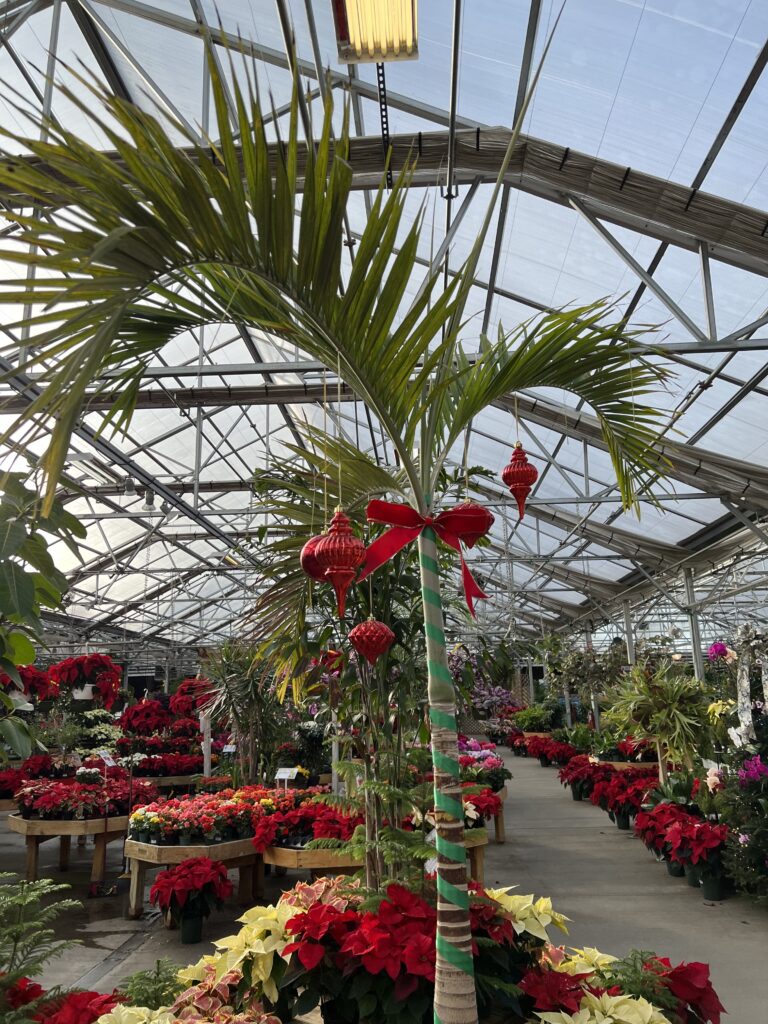The Christmas Palm is an unassuming but popular variety of palm that many in warmer, more humid climates choose. Unlike other varieties of palm, the Christmas Palm does not grow to substantial heights with a broad canopy, which means that it fits better into the average homeowner’s yard. With cream-colored flowers and clusters of red fruit by Christmas-time, the Christmas Palm is sure to impress any time of year!

Characteristics of the Christmas Palm
There are some unique characteristics of the Christmas Palm that you may not see in other varieties of palm:
- Has a greyish single trunk with with stiff, green leaves that create a canopy
- Native to tropical environments like Malaysia and the Philippines
- Has clusters of cream flowers in summer that then become fruit red fruit in winter
- The name Christmas Palm comes from when its fruit are ripe, in winter around Christmas time
- Self-pruning, meaning that old, brown leaves fall off without you pruning the tree
Light & Temperature Requirements
Christmas Palms grow best in full sunlight but can also tolerate some shade.
You will also see the best growth in outdoor Christmas Palms in tropical and humid climates. Christmas Palms are intolerant to cold and freezing temperatures. Do not allow your Christmas Palm to be out in temperatures lower than 30 degrees.
If you live in the northern United States – or anywhere north of Florida – your Christmas Palm will do better in a pot where you can control the amount of light it gets and the temperature that it grows on.
Water Requirements
Keeping your Christmas Palm adequately watered is not as difficult or as daunting as you might think.
Christmas Palms prefer moist but well-draining soil.
When you water your Christmas Palm, make sure to water deeply but do not saturate the soil so much that the soil begins to float.
Put yourself on a schedule to water your Christmas Palm every week with about 1-2 inches of water. Since you will likely live in a hotter environment, take care to give your Christmas Palm extra water if you are currently in a drought.
Root rot is not a major concern with Christmas Palms, but the Christmas Palm still does not like too much water around its roots.

Where Is The Best Place to Plant a Christmas Palm?
Outdoor climate will be the biggest factor as to whether or not you can plant your palm outside, but if you do choose to plant one outside, you have options.
Since Christmas Palms are not excessively tall, you can plant your Christmas Palm at nearly any house without the worry that it will overpower the house.
You can plant your Christmas Palm:
- In any outdoor landscape near your home
- Along driveways, walkways or patios
- In pots that can be used as accents in garden features
- In clusters of two or three palms
One of your main concerns with the Christmas Palm will be the clusters of fruit that will eventually fall in the winter months. The bright red fruits will end up in your yard and on your walkways, meaning that this plant may not be the best to put along main walkways that you prefer to keep clear.
Do Christmas Palms Grow Well in Pots?
Despite its ability to grow to a substantial height, Christmas Palms grow well in pots and other containers.
Christmas Palms are a single trunk palm, so your Christmas Palm will grow tall rather than wide. This makes growth in a pot simple.
Plus, a container means that you can easily move your Christmas Palm inside or outside depending on the weather.
If you plan to use a pot, make sure to:
- Use a pot that is terracotta, not plastic or glass
- Use well-draining soil
- Find a pot with drainage on the bottom to prevent overwatering

How Fast Will A Christmas Palm Grow?
Compared to other palm varieties, the Christmas Palm grows quickly.
Christmas Palms will not shoot up to a massive height in a short timeframe.
You will see the most growth happen in your Christmas Palm as it grows to about six feet tall. Your Christmas Palm will consider to grow as it reaches a maximum height of nearly 25 feet, but the growing will not be as fast as it was in the early days.
How Tall Does A Christmas Palm Grow?
Christmas Palms can grow anywhere between 15 to 25 feet tall.
As mentioned, the Christmas Palm will seem to grow like a weed up to about six feet tall. You may even feel like your Christmas Palm will never reach anything more than 10 feet tall.
Though slow-growing, your Christmas palm will indeed to continue to grow. Not all Christmas Palms will reach a maximum height of 25 feet. You can, however, rest well knowing that your Christmas Palm will keep growing, and its 5-6 foot wide canopy will continue to expand in tandem with its height.
What If I Don’t Trim My Christmas Palm?
Your Christmas Palm is self-pruning if you do not prune or trim your palm yourself.
Self-pruning simply means that old or dead leaves will fall from your Christmas Palm without you intervening at all.
The only downside to self-pruning is that falling leaves will:
- Fall haphazardly in yards and on walkways
- Could hit someone when they fall
- Create a mess in your yard
- Need to be cleaned up at some point
What Is Wrong With My Christmas Palm?
The Christmas Palm is not immune to disease, but the most common diseases that you may experience are:
- Lethal yellowing, which causes discoloration of its leaves that will eventually kill them
- Boron deficiency that will cause the leaves on your Christmas Palm to curl
Unfortunately, lethal yellowing is incurable. Since there is no cure, the best thing you can do for your Christmas Palm is to prevent lethal yellowing. Do not plant your Christmas Palm near palms that are already infected with lethal yellowing.
Boron deficiency, on the other hand, is much easier to deal with. A fertilizer made specifically for palms will help add much-needed nutrients back into the soil.


